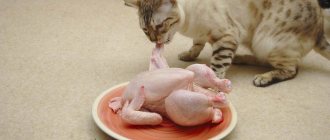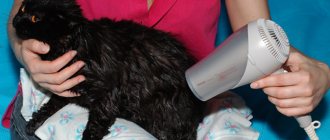Neutered cat
There is a misconception that a cat cannot be sterilized before the first birth. There is no need to wait until the pet lambs, especially if the owners do not plan to have kittens in the future. If a cat does produce offspring, the question often arises about its sterilization, in particular, how much time should pass so that the operation does not harm the animal?
In the article, we discussed when a cat can be sterilized after giving birth, how long it should take, and whether surgery is possible during lactation. You will also learn when the procedure is contraindicated and recommendations.
Indications for sterilization
If the owner does not plan to periodically receive offspring from his cat, then veterinarians recommend sterilization. The procedure will not only keep the house calm, but will also protect your mustachioed pet from many diseases. In this case, it is important to take into account the age characteristics and health status of the pet, choose the right method of intervention, and know the nuances of care after the operation.
There are both pros and cons to neutering cats, as outlined in the table below.
To be or not to be?
pros
- You don't have to get rid of kittens.
- The animal's behavior will not cause any inconvenience.
- Timely sterilization helps to increase the life expectancy of your pet.
- It is possible to prevent the development of many diseases of the cat’s reproductive system associated with estrus without mating, childbirth and hormonal changes.
- The risk that your pet will get lost or become infected with an infectious disease in case of escape is reduced to a minimum.
Minuses
- Surgery under anesthesia is stressful for the animal’s body.
- The likelihood of complications developing in the postoperative period.
- The risk of developing obesity, diabetes and other diseases associated with changes in hormonal levels.
- Recovery takes a long time (about two weeks) and requires constant wearing of special devices.
- If the owner “changes his mind”, it will be impossible to restore the ability to give birth to kittens.
In addition to the fact that sterilization of a cat is carried out due to the desire of the owner, the operation can have a therapeutic purpose and be planned or emergency.
Among the indications:
- neoplasms in the reproductive organs;
- inflammatory processes;
- changes in the mammary glands caused by hormones;
- poorly performed earlier sterilization;
- prevention of various diseases (tumors, cysts, purulent processes, and so on).
For some medical indications, the uterus and appendages are removed immediately after childbirth.
These include:
- atonic bleeding;
- placental defects;
- uterine rupture;
- pathologies of the uterus and ovaries (tumors, endometriosis) detected during pregnancy.
These indications can only be determined by a veterinarian. After such manipulations, your pet requires special care with a long recovery period.
Sterilization - a solution or a necessity?
Sterilization or castration: what is the difference?
When sterilizing a cat, one is limited to simple tubal ligation. The genital organs remain functioning normally after surgery.
Sterilization does not affect the animal’s attraction to the opposite sex, instincts do not decrease, their intensity does not change in any way. A cat can mate, but it will not produce offspring.
During castration, all organs responsible for reproduction are completely removed. The uterus and ovaries are removed (ovariohysterectomy) or only the ovaries (oophorectomy).
Previously, veterinarians only removed the ovaries of young nulliparous cats. However, now in most cases an ovariohysterectomy is performed, since removal of the ovaries alone does not avoid gynecological problems.
Laparoscopic sterilization is becoming increasingly important. Its advantages:
- Minimal trauma. During the operation, a small incision is made. Surgical instruments are inserted through it and manipulations are performed.
- Small seam size. It is also possible to apply cosmetic stitches - in this case they will not need to be removed later.
- There is no need for complex postoperative wound treatments.
- Less pain after surgery due to minor skin damage.
In a typical operation, two types of sutures are applied. Firstly, these are internal sutures that are placed on the peritoneum, abdominal muscles; A special absorbable material is used, which does not need to be removed after surgery.
There are also external seams. They do not dissolve and need to be removed after about 10-12 days.
There is also an external cosmetic suture with its own special application technique and the use of absorbable material.
In sterilized animals, the reproductive system continues to function even though they cannot have offspring. Hormonal storms negatively affect them.
Neutered cats are still susceptible to stress, as well as a high risk of developing diseases of the genitourinary system. In such cases, the cat loses weight, does not eat and behaves aggressively towards the owner.
Neutered animals live on average several years longer than sterilized ones. Among castrated cats, true long-livers are often found.
After the procedure, they behave much more friendly and adequately, do not mark their territory and do not scream. Due to the absence of genital organs, the risk of any diseases occurring in them is completely eliminated.
Some animals may require this operation for health reasons, so it is better to take the necessary measures while your pet is still young, strong and will tolerate anesthesia and surgery well.
Castration
It is the surgical removal of reproductive organs: the ovaries and uterus in a cat, or the testicles in a cat. The operation is performed under general anesthesia. There are several methods of castration.
Most often, females have all their reproductive organs removed: the ovaries, uterus and fallopian tubes. But in some cases (young cats) the uterus is left.
Castration of a female is an abdominal operation, a fairly serious surgical intervention. Therefore, it makes sense to spend money on endoscopic (laparoscopic) castration .
This is the most modern and least traumatic method. The instruments are inserted through two (sometimes three) small incisions on the abdomen, which greatly reduces the risk of infection in the abdominal cavity, facilitates and shortens the postoperative period. The incisions are so small that stitches are not required - they are sealed with medical glue.
Castration is a surgical procedure
Sterilization
It is also performed under general anesthesia, but all organs remain in their places. A surgeon ligates a cat's fallopian tubes.
What does such an operation give? Only inability to fertilize . All the rest:
- the production of sex hormones, sexual desire and all sorts of “disgrace” that accompany it, as well as urine markings, are not going away. And this operation is also much more complicated.
is ABSOLUTELY pointless for both the animal and its owner .
The cat still suffers from the inability to satisfy its natural needs, the owners stubbornly cover up the marks and patiently listen to the calling howl.
You can sterilize a cat, either a cat that has given birth or a cat that has not given birth.
Is it possible to sterilize a cat that has given birth?
Owners often wonder: when is it possible to sterilize a cat after giving birth? It is best to sterilize a cat not after giving birth, but immediately before the first heat, i.e. about a year. However, it is possible to sterilize a cat after the first birth, for the indications listed above or if there is no need for mating.
The time of the operation depends on the feeding of the kittens: 2-4 weeks need to be waited for a non-breastfeeding cat and 2-3 months for a nursing mother cat. The minimum period between births for non-lactating cats is 3 months, for nursing cats it is about 4-5, so the optimal time for sterilization after the birth of kittens is 2 months.
It is impossible to carry out the intervention immediately after lambing, since the uterus has not yet acquired its previous appearance and hormonal disorders have not recovered. During pregnancy, the uterus changed its shape, size and grew thicker with blood vessels, so any surgical manipulations in the postpartum period can stimulate heavy bleeding. In addition, it loses its elasticity, making it difficult for the surgeon to apply a ligature, which also stimulates hemorrhage.
The optimal time for sterilization after childbirth is 2 months
It is not advisable to sterilize during postpartum heat. The operation itself does not threaten the animal, but the stitches heal much more difficult. Also, you should not allow your pet to come into contact with an uncastrated cat at this time, which is even more harmful than sterilization itself. Hasty haste in this matter is a great risk to the life of the pet.
If the cat gave birth
If a cat has given birth but is not nursing kittens, sterilization is permissible at least 3 weeks after birth. But this is risky and is done only in emergency cases.
The best option is 2 months after the first birth. During the postpartum period, the uterus is enlarged and actively contracting; the operation will lead to serious blood loss. In addition, the animal’s body is weakened and anesthesia will have a negative effect.
Read also: What to do if a fire starts?
Some experts allow the procedure to be performed in the first half of pregnancy (if kittens are not desired). In this case, the ovaries and uterus will be removed along with the embryos. After this, your pet will lose interest in cats and will not be attracted to them.
Attention!
Sterilization of cats after birth for up to 1.5-2 months is a serious risk to the health of the animal!
What else do you need to know?
If the decision is made to sterilize:
- Be sure to give your cat all the necessary tests and examinations, do not neglect this.
- Prepare for the rehabilitation period. You will need: a special bandage (blanket), suture treatment products, painkillers and other medications as recommended by a veterinarian.
- The cat will need special food (low-fat, balanced, rich in microelements and vitamins).
- After surgery, the animal will need comfort and rest.
- If the veterinarian prescribes antibiotics, you will have to inject them yourself.
- On the first day after the procedure, you will have to stay close to your pet, since recovery from anesthesia can be unpredictable. It lasts about a day.
Sterilization cannot be carried out:
- During the period of heat.
- Immediately after birth.
- During the feeding period of kittens.
- When pregnant beyond 4 weeks.
Feeding period for kittens
Sterilization during lactation is highly undesirable. There are several reasons for this:
- The mammary glands of a nursing cat are enlarged and filled with milk; infection there can lead to mastitis or a mammary abscess.
- Milk can get into the surgical wound and cause infection.
- Often after the operation the cat will lose milk and the kittens will have to be fed artificially.
- Wound healing during the feeding period is long and difficult. The blanket that covers the wound will have to be removed to feed the kittens and put on again. And this creates problems and pain.
- Anesthesia and other drugs that the cat receives will be contained in the milk, which is harmful to the kittens.
If your pet has given birth, it is better to sterilize her after the kittens are completely weaned. This is about 2 months. During this time, the animal’s body will fully recover, and the operation will take place without problems.
Sterilization during lactation
So, how long after giving birth can a cat be sterilized? Nursing mothers should hesitate with sterilization, because after the intervention, lactogenesis will stop and milk will not be produced. After the operation, the milk will last for no more than 5 days. The owners will have to buy special food and spend time feeding the kittens, something that their mother could do much easier and better. In addition, anesthetic drugs pass through the milk to the kitten, and in cases of severe overdose, they become drowsy, refuse to eat, and may even die.
If for some reason the cat does not feed her children, the operation still needs to be delayed. The risks of losing a cat are very high, because during lactation the mammary glands can be injured when feeding kittens, which in the future will cause infection of the sutures after sterilization.
It is not advisable to operate on a nursing cat.
The chance of getting pregnant while nursing kittens is very low, so it is best to wait until the cat has recovered from giving birth.
Why can’t you sterilize your pet while nursing kittens?
As can be concluded from the statements of experts, in most cases, the timing of the operation varies depending on whether the cat is nursing kittens or not. By the way, this directly affects this procedure. Even if an animal has lost its pets for some reason, for example, all the kittens died or were drowned, then the pet owner must wait at least fourteen days, after which the operation can be performed. This information is confirmed by many qualified veterinarians, so we cannot not trust it.
As for the castration procedure itself when feeding kittens, this should not be done under any circumstances. According to experts, carrying out this process while feeding babies can lead to injury to the mammary glands and even serious infection of the wound after castration. If the cat is feeding kittens, then no matter how long you wait after giving birth, you cannot begin this process while she is nursing.
Among other things, in the case of sterilization, there is a very high probability of affecting large and very important blood vessels for the life of the pet. They are located next to the mammary gland, so they can be affected very easily. In addition, if you carry out the castration procedure while breastfeeding, there is a risk that the cat’s milk will disappear. Then, in order for the kittens to survive, you will have to independently buy them special food for newborns and feed them on your own.
So, by doing sterilization while feeding you:
- you greatly risk the health of the animal, even to the point of its death;
- Doom yourself to regularly buy food for kittens;
- you will have to make your own feeding schedule and participate directly in the feeding itself.
But in some cases, if there is an uncastrated cat nearby, the cat has a very high risk of getting health problems even without sterilization. It’s no secret that estrus can begin even a week or two after giving birth. Thus, contact with a male cat will harm the cat even more than the castration procedure. Therefore, in this case, each owner will have to decide what to do. The best option is to isolate the animal after birth.
How long should it take before sterilization after childbirth?
The time of the operation depends on the feeding of the kittens: 2-4 weeks need to be waited for a non-breastfeeding cat and 2-3 months for a nursing mother cat.
Is it possible to sterilize a cat immediately after giving birth? You cannot subject your pet to surgery immediately after the birth of kittens, because the uterus has not yet reached normal size and hormonal levels have not been restored. During pregnancy, the uterus changes its shape and size and grows thick blood vessels, so any operation immediately after the birth of kittens can provoke severe bleeding. In addition, the uterus becomes less elastic, and it is more difficult for the doctor to apply a ligature. It can also cause bleeding.
Before giving birth, the animal's hormonal levels change to ensure regular contractions. When kittens are born, the cat’s body begins to rebuild and lactogenesis begins. If the doctor immediately removes the ovaries, which are the main endocrine glands, then the animal receives severe stress as a result of a lack or excess amount of sex hormones. This negatively affects the health of the pet. In addition, lactation stops, and the kittens will have nothing to eat.
The best age for sterilization is 7-8 months
Cat age and sterilization
When asked when it is better to sterilize a cat, veterinary experts answer: it would be good to do it at 7-8 months. It is believed that it is during this period of animal development that all organ systems are fully formed, the cat is ready to conceive, but there has not yet been pregnancy.
Puberty of a pet can occur earlier or later than the specified period. To determine the optimal interval, you will need to periodically show her to the veterinarian and do examinations. Performing surgery on an adult cat or a very young one is fraught with serious complications and health problems in the future. Early surgery may cause developmental delays in the animal.
What age is most preferable?
The opinions of veterinarians at what months can sterilization or castration be carried out vary. Some veterinarians believe that the procedure can be performed at any age.
Others believe that the best age for it is from 6–8 months to a year and a half, i.e., with the onset of puberty.
There is no limit to how old the operation can be - it is successfully performed on parous and nulliparous adult cats at 3–5 and 7 years of age. The main condition is that the pet is healthy at this time.
During heat
It is not recommended to spay or neuter an animal while it is walking. At this time, the reproductive organs are filled with blood, so there is a risk of high blood loss. You should wait out this period and carry out the operation immediately after it.
The most optimal solution would be to spay or neuter the cat before her first heat.
If the cat is pregnant
An animal must be spayed or neutered before or after pregnancy.
During the operation, the veterinarian removes the ovaries and the uterus, which contains the fetuses. This leads to enormous stress for the cat, heavy blood loss and other complications.
This procedure is only possible up to 6 weeks of pregnancy. If the pregnancy is at an early stage (up to 3 weeks), the owners do not always know about it. In such cases, sterilization (castration) takes place without problems.
After childbirth
To spay or neuter a cat that has recently given birth, it is better to wait until she has finished nursing her kittens. That is, she can undergo surgery a couple of months after lambing.
Of course, the pet must be healthy.
When not to sterilize
In some cases, sterilization is contraindicated.
Causes:
- Allergy to certain medications.
- The disease and the period immediately after it.
- Recent injury.
- Individual intolerance to anesthesia.
In any case, the cat must first be examined by an experienced veterinarian and give an opinion. Additional examination may be required to identify other contraindications.
Castration is not recommended after 10 years of age, since the risk of postoperative complications is very high. The same applies if the cat is too young; surgery can slow down the development of the animal.
Side effects
Pet aggression is one of the side effects of the operation.
Side effects include:
- shiver;
- involuntary urination;
- aggressiveness.
In addition, the health of the animal is seriously compromised.
There is a huge risk of developing pathologies. Therefore, it is better to wait for a safe period.
Sterilization immediately after birth is done only in emergency cases, if the cat, for example, has pathologies in the uterus and ovaries. In this case, consultation with an experienced veterinarian is necessary.
Emergency cases
There are situations when an animal has to be operated on during pregnancy. This problem doesn't happen often.
Indications for sterilization when bearing offspring are:
- serious pathologies requiring immediate surgical intervention;
- high probability of death of the animal during childbirth;
- offspring unwanted by the owner;
- injuries and infectious diseases in a cat, due to which cubs may be born with defects.
Sometimes cats may need emergency sterilization
Serious and life-threatening pathologies that require surgical intervention even during pregnancy and in the first days after childbirth are:
- pyometra – inflammation of the uterus, accompanied by the accumulation of large amounts of pus;
- hematometra - accumulation of blood in the uterine cavity;
- hydrometer - filling the uterine cavity with liquid;
- endometritis – inflammation of the uterine mucosa.
There is no other treatment other than sterilization for the above diseases.
Is it possible to alternate between different types or brands?
When choosing industrial food for your pet, you should remember that they differ in content. Therefore, it is necessary to choose one brand that is most suitable. Canned food is superior to biscuits due to the increased humidity. When feeding this type of food, your cat will require much less additional fluid. Wet and dry food of the same brand can be alternated. For example, constantly feed “drying”, and once a day give canned food or pates as a treat.
You can alternate types and brands of food only within the same brand!
Preparing for surgery
- Choosing a clinic. A few weeks before the proposed procedure, you need to start looking for a good and reputable veterinarian. You need to understand that highly qualified and experienced specialists do not provide services cheaply.
- Diet. Both before the operation and during rehabilitation, the pet should follow a diet. If the cat eats natural food, then the diet should be based on boiled beef and poultry. If the animal is accustomed to dry food, then you need to buy premium food.
- Medical supplies. It is necessary to purchase a collar that will prevent the animal from licking and biting the operated area. You should also ask your veterinarian what medications to buy for treating postoperative sutures. Treatment is carried out within 10 days after the procedure. To prevent the cat from tearing the seams with its claws, many owners purchase a belly bandage.
- A place for rehabilitation. The recovery from anesthesia is individual for each animal: some cats regain consciousness a couple of hours after the operation, while others remain lethargic and drowsy all day. For comfortable rehabilitation, a cat needs to build a soft bed and place it in a quiet and shaded place. During the recovery period, the cat should not be pulled or shouted at.
- Painkillers. The animal will experience pain in the abdomen for several days. Therefore, it is impossible to do without anesthetics. Among human medicines, Papaverine, No-shpa, and Ketonal are suitable for animals. The dosage and therapeutic course are prescribed by the veterinarian. It is forbidden to choose painkillers for your pet at your own discretion, since many human medications are dangerous for cats.
Preparing a cat for sterilization
Caring for an operated animal
After surgery, the animal requires special care.
If you are given a cat who has not yet recovered from anesthesia, it should be carefully brought home in a carrier and placed on a clean, warm bedding.
After surgery, your pet may not be able to control the urge to defecate or urinate.
It is advisable to limit active movements for several hours after surgery, as the cat’s coordination of movements may be impaired.
You should start feeding her with a teaspoon and little by little to avoid vomiting.
When getting an animal, you should remember the words of the wonderful writer Saint-Exupery: “We are responsible for those we have tamed.”
Possible postoperative complications
Complications can be expressed in the form of lethargy and drowsiness, enlarged mammary glands, hernia, lack of appetite, abnormal bowel movements, changes in body temperature, the appearance of a rash, bleeding of the suture, heavy breathing, accompanied by wheezing, pallor or redness of the mucous membrane. Typically, all these symptoms go away on their own within a day or two.
Owners need to take into account that sterilization can lead to complications associated with the mental and physical condition of the animal. Many cats show aggression after surgery and become prone to obesity. Some pets experience problems with the digestive tract; food is poorly digested and leaves the intestines almost undigested.
There are problems with the urinary organs, urinary incontinence is noted, and visiting the litter box is accompanied by pain.
After the operation, a bandage is put on to prevent the cat from licking the stitch.
Mr. Cat recommends: what to feed a cat after sterilization
A pet that has undergone surgery needs special care and extra attention.
The pet is only allowed water for the entire day after surgery. On the second day, the cat is fed meat, fish or wet food twisted through a meat grinder.
The main thing to remember is that after sterilization, the cat’s digestive system noticeably weakens, so it cannot cope with solid food. Food should not be hot or cold. The food is heated until warm.
You can also learn more about how to feed a cat after spaying or neutering, and what food is best to give her.
Veterinarian recommendations
Below are some recommendations based on the most frequently asked questions about this surgery.
- Before performing surgery, the age of the cat must be taken into account. Intervention performed too early or late entails many complications.
- Nursing cat mothers need to delay sterilization until the end of the lactation period. The body will fully recover in at least 2 weeks after the kittens are taken from their mother.
- If the cat does not feed the offspring, the operation cannot be performed earlier than a month after birth.
- A cat needs to give birth at least once before being spayed - a common misconception. This in no way affects the health of the pet or the operation. If you do not need kittens in the future, you need to sterilize at the earliest possible date.
- Before 4 weeks of pregnancy, it is quite possible to carry out sterilization, if necessary.
- Get tested and get the necessary vaccinations, they will help protect your pet from infection.











